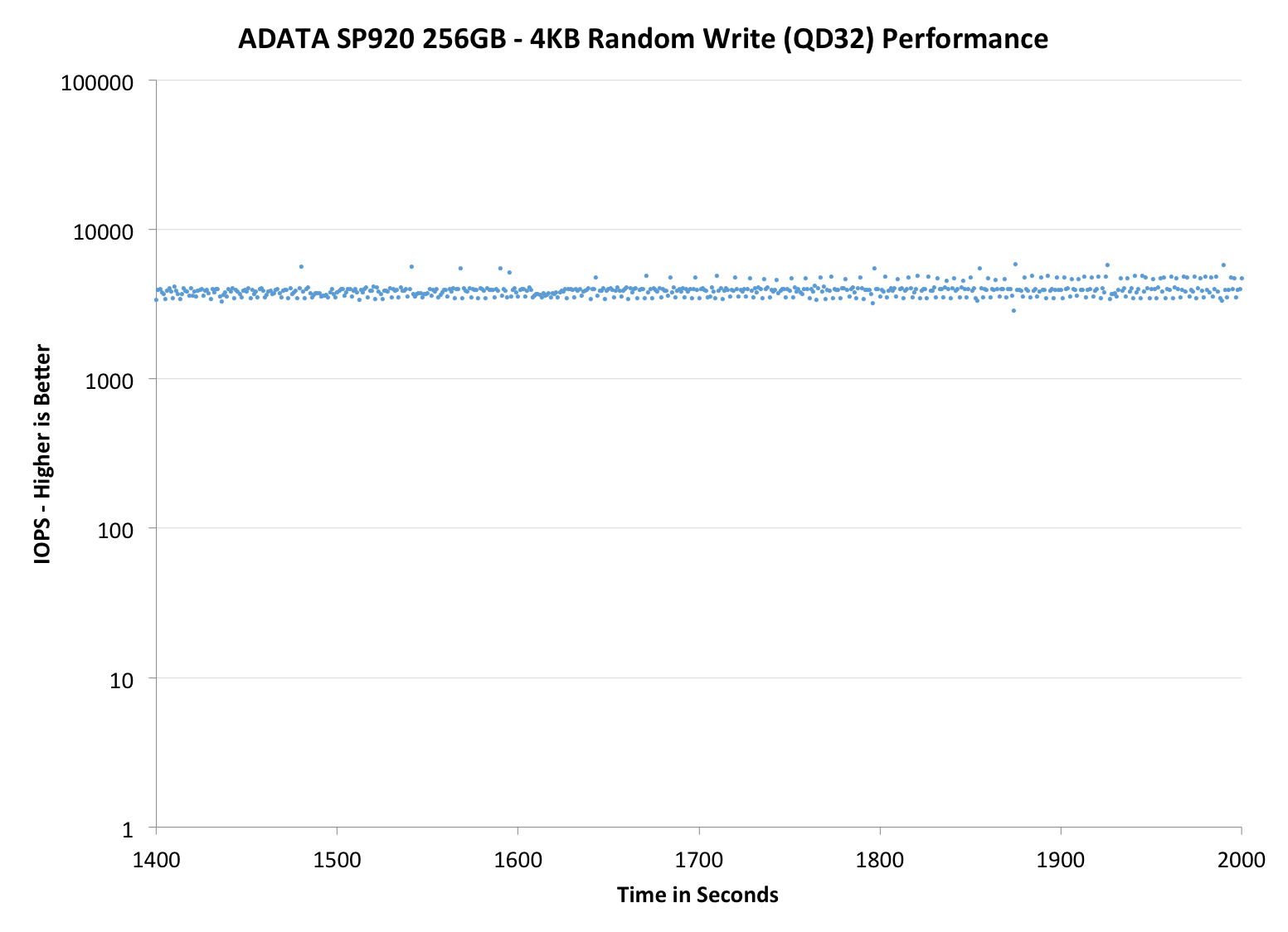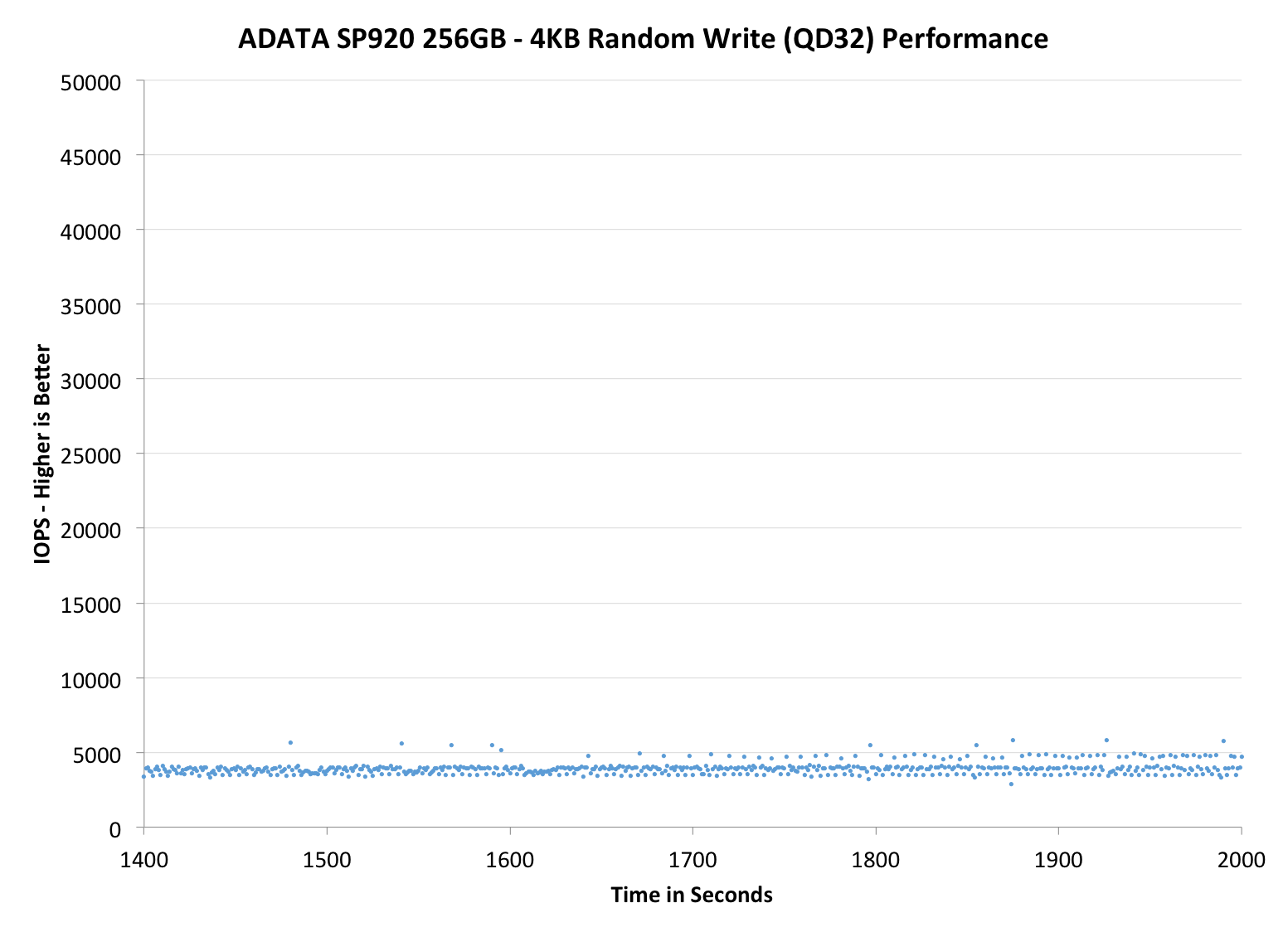ADATA SP920 (128GB, 256GB, 512GB & 1TB) Review
by Kristian Vättö on April 1, 2014 8:30 PM ESTPerformance Consistency
Performance consistency tells us a lot about the architecture of these SSDs and how they handle internal defragmentation. The reason we don’t have consistent IO latency with SSD is because inevitably all controllers have to do some amount of defragmentation or garbage collection in order to continue operating at high speeds. When and how an SSD decides to run its defrag or cleanup routines directly impacts the user experience as inconsistent performance results in application slowdowns.
To test IO consistency, we fill a secure erased SSD with sequential data to ensure that all user accessible LBAs have data associated with them. Next we kick off a 4KB random write workload across all LBAs at a queue depth of 32 using incompressible data. The test is run for just over half an hour and we record instantaneous IOPS every second.
We are also testing drives with added over-provisioning by limiting the LBA range. This gives us a look into the drive’s behavior with varying levels of empty space, which is frankly a more realistic approach for client workloads.
Each of the three graphs has its own purpose. The first one is of the whole duration of the test in log scale. The second and third one zoom into the beginning of steady-state operation (t=1400s) but on different scales: the second one uses log scale for easy comparison whereas the third one uses linear scale for better visualization of differences between drives. Click the buttons below each graph to switch the source data.
For more detailed description of the test and why performance consistency matters, read our original Intel SSD DC S3700 article.
 |
|||||||||
| ADATA SP920 | Crucial M550 | Intel SSD 730 | SanDisk Extreme II | Samsung SSD 840 EVO | |||||
| Default | |||||||||
| 25% Spare Area | - | ||||||||
As expected, the IO consistency is the same as in the M550 and even the capacity variations and over-provisioning behavior match. Like I said in the M550 review, I'm not very satisfied with the IO consistency compared to what we've seen lately but at least ADATA is positioning the SP920 as a mainstream value drive.
 |
|||||||||
| ADATA SP920 | Crucial M550 | Intel SSD 730 | SanDisk Extreme II | Samsung SSD 840 EVO | |||||
| Default | |||||||||
| 25% Spare Area | - | ||||||||
 |
|||||||||
| ADATA SP920 | Crucial M550 | Intel SSD 730 | SanDisk Extreme II | Samsung SSD 840 EVO | |||||
| Default | |||||||||
| 25% Spare Area | - | ||||||||
TRIM Validation
To test TRIM, I took a secure erased 128GB SP920 and filled it with sequential data. Then I tortured the drive with 4KB random writes (QD32) for 40 minutes followed by a TRIM command (quick format in Windows). Finally I measured performance with HD Tach to bring you the graph below:
And as you should expect, TRIM works.











30 Comments
View All Comments
Guspaz - Thursday, April 3, 2014 - link
I agree. I read the whole article more often than not, but on some articles, where I'm pressed for time or don't have the same degree of interest in the subject of the review, I just read the introduction and the final words. As such, getting the gist of the whole article is very important.Heck, even when I do read the whole article, it's still important. Sometimes a good summary at the end points out things that I missed, or gives me a better idea how to interpret the results.
Kristian Vättö - Thursday, April 3, 2014 - link
I've been with AnandTech for three years now, so I'm not exactly new :)Since the SP920 is a rebranded M550, I think it's a must to look at the M550 review as well, which is why I referred to it so much. Now that I look it at, a mention of the SP920's position in the market wouldn't have hurt but as I mentioned in the introduction, our M550 review has broad coverage of that along with plenty of other stuff.
hrrmph - Wednesday, April 2, 2014 - link
Adata claims to have a software toolbox to ease the inconvenience of occasionally needing to do a Secure Erase and other functions. Crucial / Micron doesn't seem to offer that.Samsung offers RAM caching software. Neither Adata nor Crucial / Micron seems to offer that.
hrrmph - Wednesday, April 2, 2014 - link
I would really appreciate it if the hole in the chart could be filled (the Samsung EVO's ratings with 25% spare area).I take it that getting the sample drives from Samsung has been difficult?
Kristian Vättö - Thursday, April 3, 2014 - link
We do have EVO samples (well, Anand has, I don't) but you can see the EVO's OP behavior in the EVO mSATA reviewhttp://www.anandtech.com/show/7594/samsung-ssd-840...
nofly - Friday, April 4, 2014 - link
Will those PCIe drives mentioned in the article be an upgrade option for older motherboards (like a PCIe card) or will new hardware be required ?Kristian Vättö - Friday, April 4, 2014 - link
Most PCIe SSDs in the near future will likely be just regular PCIe cards. Later we may see transition to 2.5" when/if SATA Express becomes a standard.Alientech - Saturday, April 5, 2014 - link
The new ST3000DM001-1E6166 drives with the FC4x firmware seems to be using Shingled Magnetic Recording. Which means we need SSD caching all the more. Sure wish every one would pack one with the drive. With HDD write speeds dropping through the floor now, its a must. Even 250MB write speeds of a SSD is a huge improvement.sammarth - Monday, April 28, 2014 - link
<a href="http://seoexpertzs.wordpress.com">Sammarth... nice thanks for share usgamoniac - Wednesday, May 20, 2015 - link
Hi Kristian, on power consumption, you mentioned you were posting an update with HIPM+DIPM enabled. I searched through AT but didn't find any update. I know this is a year-old article but it would be nice to see that, since there were some SP920 on sales now. It seems like a pretty solid drive with very competitive pricing (256GB for $89 on newegg). Thanks.